Technology
PROPERTY| ROTATIONAL MOULDING
Rotational molding is an atmospheric pressure process that produces nearly stress-free parts. The fact that there are no stresses on the melt as it is shaped is a major advantage that rotational molding has over all other manufacturing methods for plastics parts. Also, as there are no forces on the plastic melt during forming, rotational molds can have thin walls and are relatively inexpensive to fabricate. For simple parts, mold delivery times can be a few days or weeks. Modern, multi-armed machines allow multiple molds of different sizes and shapes to be run at the same time. With proper mold design, complex parts, such as double-walled containers, that are difficult or impossible to mold by any other method, can be rotationally molded. With correct process control, the wall thickness of rotationally molded parts is quite uniform, unlike structural blow molding or twin-sheet thermoforming.
RIBS
Stiffening ribs are used mainly for reinforcement and increase the stiffness without increasing the part wall thickness. In rotational moulding ribs with fins cannot be used as the way they are used in injection moulding to stiffen thin surface areas. The powder would be unable to enter into the deep cavities of the mould and the resultant stiffening
would be poor.
